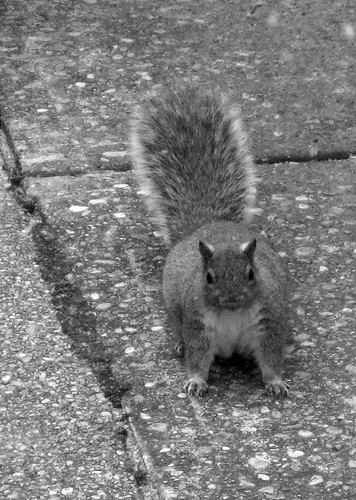All of these images are from the conservation lab at the
Imperial War Museum
Cleaning a photo
To clean the surface of the photo, Tina carefully rolls (never rubs) a swab across it to pick up any dirt or dust.

Repairing a photo
Any small rips or tears in the photographs are repaired using wheat starch paste

Repairing a photo step 2
The paste is applied to the card mount, not the underside of the photo surface, so that the card can absorb the excess moisture in the paste.

Photo consevation in action
Conservator Tina Kelly working on a photo album that will appear in the exhibition. The cushion is used to support the cover of the album when condition reporting. Without the cushion, which is actually more like a bean bag that can be squished the required shape, the spine could break.

Get yer gloves on!
Gloves must be worn when handling photographs as fingerprints can damage the gelatine that forms the surface of the photo.

Wheat starch paste
Don't eat this in class...
------------

Sword cleaning
Conservator Heidrun Gassner cleans a British cavalry sword, dating from around 1908, with a solvent (acetone) to remove any grease.

Sponge bath
However, acetone should not be used on painted surfaces. Instead, a sponge is used to clean off any surface dirt.
--------------

Tearing
Old paper is fragile and easily damaged, so any tears must be repaired before an item is handed over to the Exhibitions team for installation in a showcase.

Repairing
Tina Kelly is using wheat starch paste to attach Japanese Tengujo tissue to repair a small rip at the edge of this pamphlet. The tissue acts like sticky tape, preventing the tear from ripping further into the page.

Cleaning
When bringing the boiler out of storage, the Conservation team found that someone had covered the entire surface in sticky grease and wrapped it in greaseproof paper. Joanna Cook, above, has been hard at work with a bottle of acetone and a cotton swab, removing the grease and getting the boiler ready for display.

Museum Vac in action!
Looking after fabrics requires careful work. The scarf has to be carefully vacuumed using a special low suction ‘Museum Vac’ to remove dust and any remnants of old pest damage. Dust is particularly harmful to fabric - it can attract pests, can cause staining and can damage delicate fibres.
Labels: conservation, environment, flickr, history, photography, pictures, preservation, tools




















